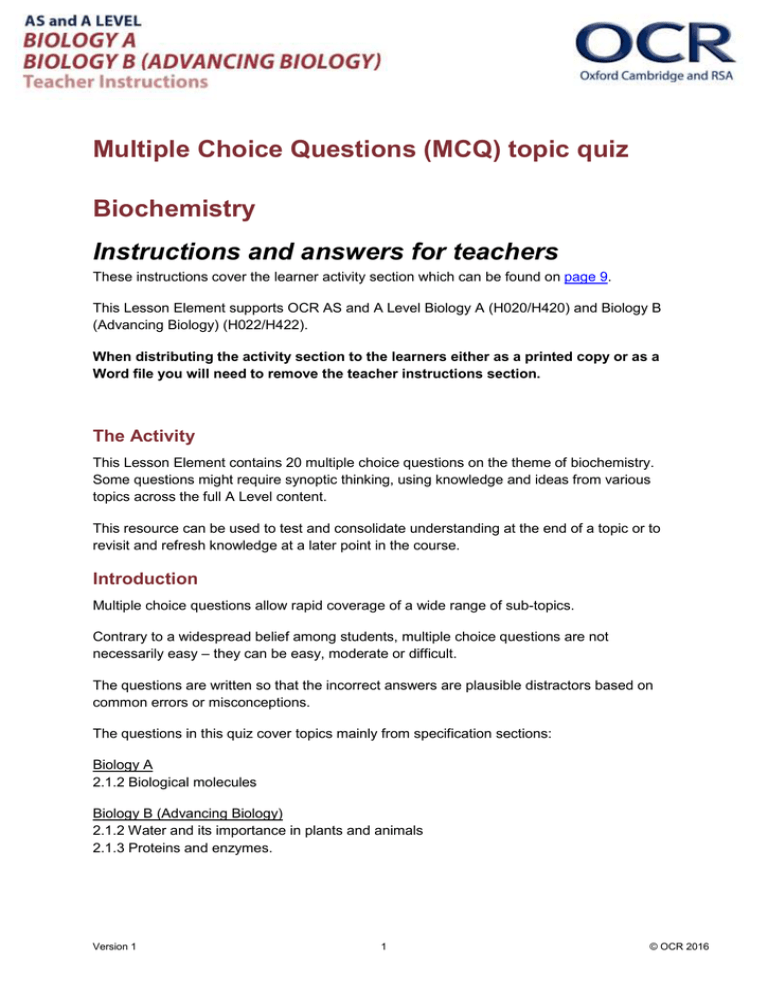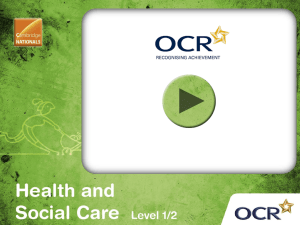Biochemistry MCQ Quiz for A Level Biology
advertisement

Multiple Choice Questions (MCQ) topic quiz Biochemistry Instructions and answers for teachers These instructions cover the learner activity section which can be found on page 9. This Lesson Element supports OCR AS and A Level Biology A (H020/H420) and Biology B (Advancing Biology) (H022/H422). When distributing the activity section to the learners either as a printed copy or as a Word file you will need to remove the teacher instructions section. The Activity This Lesson Element contains 20 multiple choice questions on the theme of biochemistry. Some questions might require synoptic thinking, using knowledge and ideas from various topics across the full A Level content. This resource can be used to test and consolidate understanding at the end of a topic or to revisit and refresh knowledge at a later point in the course. Introduction Multiple choice questions allow rapid coverage of a wide range of sub-topics. Contrary to a widespread belief among students, multiple choice questions are not necessarily easy – they can be easy, moderate or difficult. The questions are written so that the incorrect answers are plausible distractors based on common errors or misconceptions. The questions in this quiz cover topics mainly from specification sections: Biology A 2.1.2 Biological molecules Biology B (Advancing Biology) 2.1.2 Water and its importance in plants and animals 2.1.3 Proteins and enzymes. Version 1 1 © OCR 2016 Multiple Choice Questions (MCQ) topic quiz - answers 1 A 0.5 mol dm3 solution of sucrose was heated at 80 °C for 5 min with Benedict’s reagent. What was the resulting colour? A blue B blue-black C purple D brick-red Your answer 2 A A carbon compound extracted from living tissue was found to contain exactly twice as many hydrogen atoms as oxygen atoms. To which of the following classes of biological molecule is it likely to belong? A carbohydrate B lipid C nucleic acid D protein Your answer Version 1 2 A © OCR 2016 For the processes shown in questions 3-6, identify the reaction type A – D. 3 4 5 6 A reduction B oxidation C hydrolysis D condensation maltose → glucose Your answer C Your answer D Your answer B Your answer B amino acids → polypeptide cytochrome C Fe 2+ → cytochrome C Fe 3+ NADH → NAD+ Version 1 3 © OCR 2016 Below are four types of bond. For questions 7-10, identify the bonds found in the biological molecule. 7 8 9 A glycosidic B peptide C ester D phosphodiester Haemoglobin Your answer B Your answer C Your answer B Your answer D Triglyceride Collagen 10 RNA 11 Which of these compounds would contain the smallest number of oxygen atoms? A a saturated fatty acid B a polypeptide C a polysaccharide D glycerol Your answer Version 1 4 A © OCR 2016 12 What is the general formula for a disaccharide? A C12H25O12 B C12H24O11 C C12H22O12 D C12H22O11 Your answer D Your answer B 13 Which one of these carbohydrates contains 1-6 glycosidic bonds? A amylose B amylopectin C maltose D cellulose 14 On complete hydrolysis, which of the following would produce the fewest molecules? A phospholipid B triglyceride C sucrose D polypeptide Your answer Version 1 5 C © OCR 2016 15 Which monosaccharide is shown in the diagram below? A ribose B deoxyribose C α glucose D β glucose Your answer D 16 Amino acids vary according to their R group. Which one of the following R groups would be hydrophobic? A CH3 B CH2 OH C CH2 COOH D H Your answer Version 1 6 A © OCR 2016 17 Substances which can act as both acid and base are used in experiments to maintain a constant pH. What are the substances known as? A polar molecules B buffers C cofactors D reducing agents Your answer B 18 Which of the following molecules does not yield only α glucose molecules on complete hydrolysis? A amylose B glycogen C maltose D sucrose Your answer D 19 Which of these techniques could be used to separate molecules according to their differential solubility in a given solvent? A electrophoresis B chromatography C ultracentrifugation D filtration Your answer Version 1 7 B © OCR 2016 20 How many different tripeptides can be made using the 20 commonly occurring amino acids? A 40 B 400 C 4000 D 8000 Your answer D This resource has been produced as part of our free Biology teaching and learning support package. All the Biology teaching and learning resources, including delivery guides, topic exploration packs, lesson elements and more are available on the qualification webpages. If you are looking for examination practice materials, you can find Sample Assessment Materials (SAMs) and a link to the Practice Papers on the qualification webpages: Biology A, Biology B. We’d like to know your view on the resources we produce. By clicking on ‘Like’ or ‘Dislike’ you can help us to ensure that our resources work for you. When the email template pops up please add additional comments if you wish and then just click ‘Send’. Thank you. If you do not currently offer this OCR qualification but would like to do so, please complete the Expression of Interest Form which can be found here: www.ocr.org.uk/expression-of-interest OCR Resources: the small print OCR’s resources are provided to support the teaching of OCR specifications, but in no way constitute an endorsed teaching method that is required by the Board, and the decision to use them lies with the individual teacher. Whilst every effort is made to ensure the accuracy of the content, OCR cannot be held responsible for any errors or omissions within these resources. © OCR 2016 - This resource may be freely copied and distributed, as long as the OCR logo and this message remain intact and OCR is acknowledged as the originator of this work. OCR acknowledges the use of the following content: n/a Please get in touch if you want to discuss the accessibility of resources we offer to support delivery of our qualifications: resources.feedback@ocr.org.uk Version 1 8 © OCR 2016 Multiple Choice Questions (MCQ) topic quiz Biochemistry Learner Activity 1 A 0.5 mol dm3 solution of sucrose was heated at 80 °C for 5 min with Benedict’s reagent. What was the resulting colour? A blue B blue-black C purple D brick-red Your answer 2 A carbon compound extracted from living tissue was found to contain exactly twice as many hydrogen atoms as oxygen atoms. To which of the following classes of biological molecule is it likely to belong? A carbohydrate B lipid C nucleic acid D protein Your answer Version 1 9 © OCR 2016 For the processes shown in questions 3-6, identify the reaction type A – D. 3 A reduction B oxidation C hydrolysis D condensation maltose → glucose Your answer 4 amino acids → polypeptide Your answer 5 cytochrome C Fe 2+ → cytochrome C Fe 3+ Your answer 6 NADH → NAD+ Your answer Version 1 10 © OCR 2016 Below are four types of bond. For questions 7-10, identify the bonds found in the biological molecule. 7 A glycosidic B peptide C ester D phosphodiester Haemoglobin Your answer 8 Triglyceride Your answer 9 Collagen Your answer 10 RNA Your answer 11 Which of these compounds would contain the smallest number of oxygen atoms? A a saturated fatty acid B a polypeptide C a polysaccharide D glycerol Your answer Version 1 11 © OCR 2016 12 What is the general formula for a disaccharide? A C12H25O12 B C12H24O11 C C12H22O12 D C12H22O11 Your answer 13 Which one of these carbohydrates contains 1-6 glycosidic bonds? A amylose B amylopectin C maltose D cellulose Your answer 14 On complete hydrolysis, which of the following would produce the fewest molecules? A phospholipid B triglyceride C sucrose D polypeptide Your answer Version 1 12 © OCR 2016 15 Which monosaccharide is shown in the diagram below? A ribose B deoxyribose C α glucose D β glucose Your answer 16 Amino acids vary according to their R group. Which one of the following R groups would be hydrophobic? A CH3 B CH2 OH C CH2 COOH D H Your answer Version 1 13 © OCR 2016 17 Substances which can act as both acid and base are used in experiments to maintain a constant pH. What are the substances known as? A polar molecules B buffers C cofactors D reducing agents Your answer 18 Which of the following molecules does not yield only α glucose molecules on complete hydrolysis? A amylose B glycogen C maltose D sucrose Your answer 19 Which of these techniques could be used to separate molecules according to their differential solubility in a given solvent? A electrophoresis B chromatography C ultracentrifugation D filtration Your answer Version 1 14 © OCR 2016 20 How many different tripeptides can be made using the 20 commonly occurring amino acids? A 40 B 400 C 4000 D 8000 Your answer Version 1 15 © OCR 2016




